Quantitative Estimation of Soil-Ground Water Storage Utilization during the Crop Growing Season in Arid Regions with Shallow Water Table Depth
Abstract
1. Introduction
2. Materials and Methods
2.1. Study Area and Data Description
2.2. Calculation of Soil-Ground Water Storage Utilization
2.3. Moving Average Method
2.4. Water Balance Analysis to Estimate the Actual Evapotranspiration
2.5. Statistical Indicators
3. Results and Discussion
3.1. Results of the Soil-Ground Water Storage Utilization
3.2. The Impact Factors on Soil-Ground Water Storage Utilization
3.3. Results of Soil Water Storage Utilization, Ground Water Utilization, Soil-Ground Water Storage Utilization below and above 1 m Soil Depth and the Three Coefficients
3.4. Contributions of Ground Water Utilization, Soil-Ground Water Storage Utilization below 1 m Soil Depth, Soil-Ground Water Storage Utilization to the Actual Evapotranspiration
4. Conclusions
Author Contributions
Funding
Conflicts of Interest
References
- Cai, X.; McKinney, D.C.; Rosegrant, M.W. Sustainability analysis for irrigation water management in the Aral Sea region. Agric. Syst. 2003, 76, 1043–1066. [Google Scholar] [CrossRef]
- Hanasaki, N.; Fujimori, S.; Yamamoto, T.; Yoshikawa, S.; Masaki, Y.; Hijioka, Y.; Kanae, S. A Global Water Scarcity Assessment under Shared Socio-Economic Pathways–Part 2: Water Availability and Scarcity. Hydrol. Earth Syst. Sci. 2013, 17, 2393–2413. [Google Scholar] [CrossRef]
- Liu, Z.; Chen, H.; Huo, Z.; Wang, F.; Shock, C.C. Analysis of the contribution of groundwater to evapotranspiration in an arid irrigation district with shallow water table. Agric. Water Manag. 2016, 171, 131–141. [Google Scholar] [CrossRef]
- Zhang, Y.; Kendy, E.; Qiang, Y.; Changming, L.; Yanjun, S.; Hongyong, S. Effect of soil water deficit on evapotranspiration, crop yield, and water use efficiency in the North China Plain. Agric. Water Manag. 2004, 64, 107–122. [Google Scholar] [CrossRef]
- Lam, A.; Karssenberg, D.; van den Hurk, B.J.J.M.; Bierkens, M.F.P. Spatial and temporal connections in groundwater contribution to evaporation. Hydrol. Earth Syst. Sci. 2011, 15, 2621–2630. [Google Scholar] [CrossRef]
- Li, R.; Shi, H.; Flerchinger, G.N.; Akae, T.; Wang, C. Simulation of freezing and thawing soils in Inner Mongolia Hetao Irrigation District, China. Geoderma 2012, 173, 28–33. [Google Scholar] [CrossRef]
- Li, R.; Shi, H.; Flerchinger, G.N.; Zou, C.; Li, Z. Modeling the effect of antecedent soil water storage on water and heat status in seasonally freezing and thawing agricultural soils. Geoderma 2013, 206, 70–74. [Google Scholar] [CrossRef]
- Lu, X.; Li, R.; Shi, H.; Liang, J.; Miao, Q.; Fan, L. Successive simulations of soil water-heat-salt transport in one whole year of agriculture after different mulching treatments and autumn irrigation. Geoderma 2019, 344, 99–107. [Google Scholar] [CrossRef]
- Xu, X.; Huang, G.; Qu, Z.; Pereira, L.S. Assessing the groundwater dynamics and impacts of water saving in the Hetao Irrigation District, Yellow River basin. Agric. Water Manag. 2010, 98, 301–313. [Google Scholar] [CrossRef]
- Han, Y. Autumn Irrigation Schedule in Hetao Irrigation District Based on SWAP-SHAW Coupling Model. Master’s Thesis, Tsinghua University, Beijing, China., 2017. (In Chinese). [Google Scholar]
- Loheide, S.P.; Butler, J.J.; Gorelick, S.M. Estimation of groundwater consumption by phreatophytes using diurnal water table fluctuations: A saturated-unsaturated flow assessment. Water Resour. Res. 2005, 41, W07030.1–W07030.14. [Google Scholar] [CrossRef]
- Nosetto, M.D.; Jobbágy, E.G.; Jackson, R.B.; Sznaider, G.A. Reciprocal influence of crops and shallow ground water in sandy landscapes of the Inland Pampas. Field Crop. Res. 2009, 113, 138–148. [Google Scholar] [CrossRef]
- Yeh, P.J.; Famiglietti, J.S. Regional Groundwater Evapotranspiration in Illinois. J. Hydrometeorol. 2009, 10, 464–478. [Google Scholar] [CrossRef]
- Yang, J.; Li, B.; Liu, S.P. A large weighing lysimeter for evapotranspiration and soil-water-groundwater exchange studies. Hydrol. Process. 2000, 14, 1887–1897. [Google Scholar] [CrossRef]
- Wu, Y.; Liu, T.; Paredes, P.; Duan, L.; Pereira, L.S. Water use by a groundwater dependent maize in a semi-arid region of Inner Mongolia: Evapotranspiration partitioning and capillary rise. Agric. Water Manag. 2015, 152, 222–232. [Google Scholar] [CrossRef]
- Luo, Y.; Sophocleous, M. Seasonal groundwater contribution to crop-water use assessed with lysimeter observations and model simulations. J. Hydrol. 2010, 389, 325–335. [Google Scholar] [CrossRef]
- Bandyopadhyay, P.K.; Mallick, S. Actual evapotranspiration and crop coefficients of wheat (Triticum aestivum) under varying moisture levels of humid tropical canal command area. Agric. Water Manag. 2003, 59, 33–47. [Google Scholar] [CrossRef]
- Luo, Y.; He, C.; Sophocleous, M.; Yin, Z.; Hongrui, R.; Ouyang, Z. Assessment of crop growth and soil water modules in SWAT2000 using extensive field experiment data in an irrigation district of the Yellow River Basin. J. Hydrol. 2008, 352, 139–156. [Google Scholar] [CrossRef]
- Zhang, Y.; Wegehenkel, M. Integration of MODIS data into a simple model for the spatial distributed simulation of soil water content and evapotranspiration. Remote Sens. Environ. 2006, 104, 393–408. [Google Scholar] [CrossRef]
- Soppe, R.W.O.; Ayars, J.E. Characterizing ground water use by safflower using weighing lysimeters. Agric. Water Manag. 2003, 60, 59–71. [Google Scholar] [CrossRef]
- Soylu, M.E.; Istanbulluoglu, E.; Lenters, J.D.; Wang, T. Quantifying the impact of groundwater depth on evapotranspiration in a semi-arid grassland region. Hydrol. Earth Syst. Sci. 2011, 15, 787–806. [Google Scholar] [CrossRef]
- Robock, A.; Vinnikov, K.Y.; Srinivasan, G.; Entin, J.K.; Hollinger, S.E.; Speranskaya, N.A.; Namkhai, A. The Global Soil Moisture Data Bank. Bull. Amer. Meteorol. Soc. 2000, 81, 1281–1299. [Google Scholar] [CrossRef]
- Wang, Y.; Shao, M.; Liu, Z. Vertical distribution and influencing factors of soil water content within 21-m profile on the Chinese Loess Plateau. Geoderma 2013, 193, 300–310. [Google Scholar] [CrossRef]
- Qu, Z.; Liu, T.; Kang, Y.; Huang, Y. The Analysis of Different Scales Diversity Law of Irrigation Water Efficiency and Water Saving Potential in Yellow River Irrigation Areas of Inner Mongolia; Science Press: Beijing, China, 2018. (In Chinese) [Google Scholar]
- Yang, Y.; Shang, S.; Jiang, L. Remote Sensing Temporal and Spatial Patterns of Evapotranspiration and the Responses to Water Management in a Large Irrigation District of North China. Agric. For. Meteorol. 2012, 164, 112–122. [Google Scholar] [CrossRef]
- Yu, B.; Shang, S.; Zhu, W.; Gentine, P.; Cheng, Y. Mapping daily evapotranspiration over a large irrigation district from MODIS data using a novel hybrid dual-source coupling model. Agric. For. Meteorol. 2019, 276, 107612. [Google Scholar] [CrossRef]
- Yang, J.; Wan, S.; Deng, W.; Zhang, G. Water fluxes at a fluctuating water table and groundwater contributions to wheat water use in the lower Yellow River flood plain, China. Hydrol. Process. 2007, 21, 717–724. [Google Scholar] [CrossRef]
- Doble, R.C.; Crosbie, R.S. Review: Current and emerging methods for catchment-scale modelling of recharge and evapotranspiration from shallow groundwater. Hydrogeol. J. 2017, 25, 3–23. [Google Scholar] [CrossRef]
- Peng, Z.; Zhang, B.; Cai, J.; Wei, Z.; Chen, H.; Liu, Y. Optimization of Spring Wheat Irrigation Schedule in Shallow Groundwater Area of Jiefangzha Region in Hetao Irrigation District. Water 2019, 11, 2627. [Google Scholar] [CrossRef]
- Forkutsa, I.; Sommer, R.; Shirokova, Y.I.; Lamers, J.P.A.; Kienzler, K.; Tischbein, B.; Vlek, P.L.G. Modeling irrigated cotton with shallow groundwater in the Aral Sea Basin of Uzbekistan: I. Water dynamics. Irrig. Sci. 2009, 27, 331–346. [Google Scholar] [CrossRef]
- Chen, H.; Liu, Z.; Huo, Z.; Qu, Z.; Xia, Y.; Fernald, A. Impacts of agricultural water saving practice on regional groundwater and water consumption in an arid region with shallow groundwater. Environ. Earth Sci. 2016, 75, 1204. [Google Scholar] [CrossRef]
- Ren, D.; Xu, X.; Huang, G. Irrigation water use in typical irrigation and drainage system of Hetao Irrigation District. Trans. Chin. Soc. Agric. Eng. 2019, 35, 98–105. (In Chinese) [Google Scholar] [CrossRef]
- Raghavendra, N.S.; Deka, P.C. Support vector machine applications in the field of hydrology: A review. Appl. Soft. Comput. 2014, 19, 372–386. [Google Scholar] [CrossRef]
- Cheng, D.; Wang, W.; Zhan, H.; Zhang, Z.; Chen, L. Quantification of transient specific yield considering unsaturated-saturated flow. J. Hydrol. 2020, 580, 124043. [Google Scholar] [CrossRef]
- Freeze, R.A.; Cherry, J.A. Groundwater; Prentice-Hall: Upper Saddle River, NJ, USA, 1979; 604p, ISBN 0-13-365312-9. [Google Scholar]
- Moench, A.F. Specific yield as determined by type-curve analysis of aquifer-test data. Groundwater 1994, 32, 949–958. [Google Scholar] [CrossRef]
- Nwankwor, G.I.; Cherry, J.A.; Gillham, R.W. A Comparative Study of Specific Yield Determinations for a Shallow Sand Aquifer. Groundwater 1984, 22, 764–772. [Google Scholar] [CrossRef]
- Malama, B. Alternative linearization of water table kinematic condition for unconfined aquifer pumping test modeling and its implications for specific yield estimates. J. Hydrol. 2011, 399, 141–147. [Google Scholar] [CrossRef]
- Neuman, S.P. Theory of flow in unconfined aquifers considering delayed response of the water table. Water Resour. Res. 1972, 8, 1031–1045. [Google Scholar] [CrossRef]
- Gao, X.; Huo, Z.; Bai, Y.; Feng, S.; Huang, G.; Shi, H.; Qu, Z. Soil salt and groundwater change in flood irrigation field and uncultivated land: A case study based on 4-year field observations. Environ. Earth Sci. 2015, 73, 2127–2139. [Google Scholar] [CrossRef]
- Chen, H.; Huo, Z.; Dai, X.; Ma, S.; Xu, X.; Huang, G. Impact of agricultural water-saving practices on regional evapotranspiration: The role of groundwater in sustainable agriculture in arid and semi-arid areas. Agric. Meteorol. 2018, 263, 156–168. [Google Scholar] [CrossRef]
- Li, Y.; Wu, C.; Bao, M.; Gu, X. Research on the Spacing of Regional Meteorological Stations in Hulun Buir Grassland. In Proceedings of the 32nd annual meeting of Chinese Meteorological Society, Tianjing, China, 14 October 2015; Chinese Meteorological Society: Beijing, China, 2015. (In Chinese). [Google Scholar]
- Ren, D.; Xu, X.; Hao, Y.; Huang, G. Modeling and assessing field irrigation water use in a canal system of Hetao, upper Yellow River basin: Application to maize, sunflower and watermelon. J. Hydrol. 2016, 532, 122–139. [Google Scholar] [CrossRef]
- Mogheir, Y.; de Lima, J.L.M.P.; Singh, V.P. Characterizing the spatial variability of groundwater quality using the entropy theory: I. Synthetic data. Hydrol. Process. 2004, 18, 2165–2179. [Google Scholar] [CrossRef]
- Wu, C.L.; Chau, K.W.; Li, Y.S. Methods to improve neural network performance in daily flows prediction. J. Hydrol. 2009, 372, 80–93. [Google Scholar] [CrossRef]
- Evett, S.R.; Kustas, W.P.; Gowda, P.H.; Anderson, M.C.; Prueger, J.H.; Howell, T.A. Overview of the Bushland Evapotranspiration and Agricultural Remote sensing EXperiment 2008 (BEAREX08): A field experiment evaluating methods for quantifying ET at multiple scales. Adv. Water Resour. 2012, 50, 4–19. [Google Scholar] [CrossRef]
- Abdi, H. Coefficient of variation. In Encyclopedia of Research Design, 1st ed.; Salkind, N., Ed.; Sage: Thousand Oaks, CA, USA, 2010; Volume 1, pp. 169–171. [Google Scholar] [CrossRef]
- Xi, H.; Feng, Q.; Si, J.; Chang, Z.; Cao, S. Impacts of river recharge on groundwater level and hydrochemistry in the lower reaches of Heihe River Watershed, northwestern China. Hydrogeol. J. 2010, 18, 791–801. [Google Scholar] [CrossRef]
- Huang, T.; Pang, Z. Changes in groundwater induced by water diversion in the Lower Tarim River, Xinjiang Uygur, NW China: Evidence from environmental isotopes and water chemistry. J. Hydrometeorol. 2010, 387, 188–201. [Google Scholar] [CrossRef]
- Yue, W.; Liu, X.; Wang, T.; Chen, X. Impacts of water saving on groundwater balance in a large-scale arid irrigation district, northwest china. Irrig. Sci. 2016, 34, 297–312. [Google Scholar] [CrossRef]
- Steinwand, A.L.; Harrington, R.F.; Or, D. Water balance for Great Basin phreatophytes derived from eddy covariance, soil water, and water table measurements. J. Hydrol. 2006, 329, 595–605. [Google Scholar] [CrossRef]
- Nwankwor, G.I.; Gillham, R.W.; van der Kamp, G.; Akindunni, F.F. Unsaturated and saturated flow in response to pumping of an unconfined aquifer: Field evidence of delayed drainage. Groundwater 1992, 30, 690–700. [Google Scholar] [CrossRef]
- Zhang, R.; Wang, P. A preliminary study on the mechanism of water release from saturated layered soils. J. Wuhan Coll. Geol. 1985, 10, 21–27. (In Chinese) [Google Scholar]
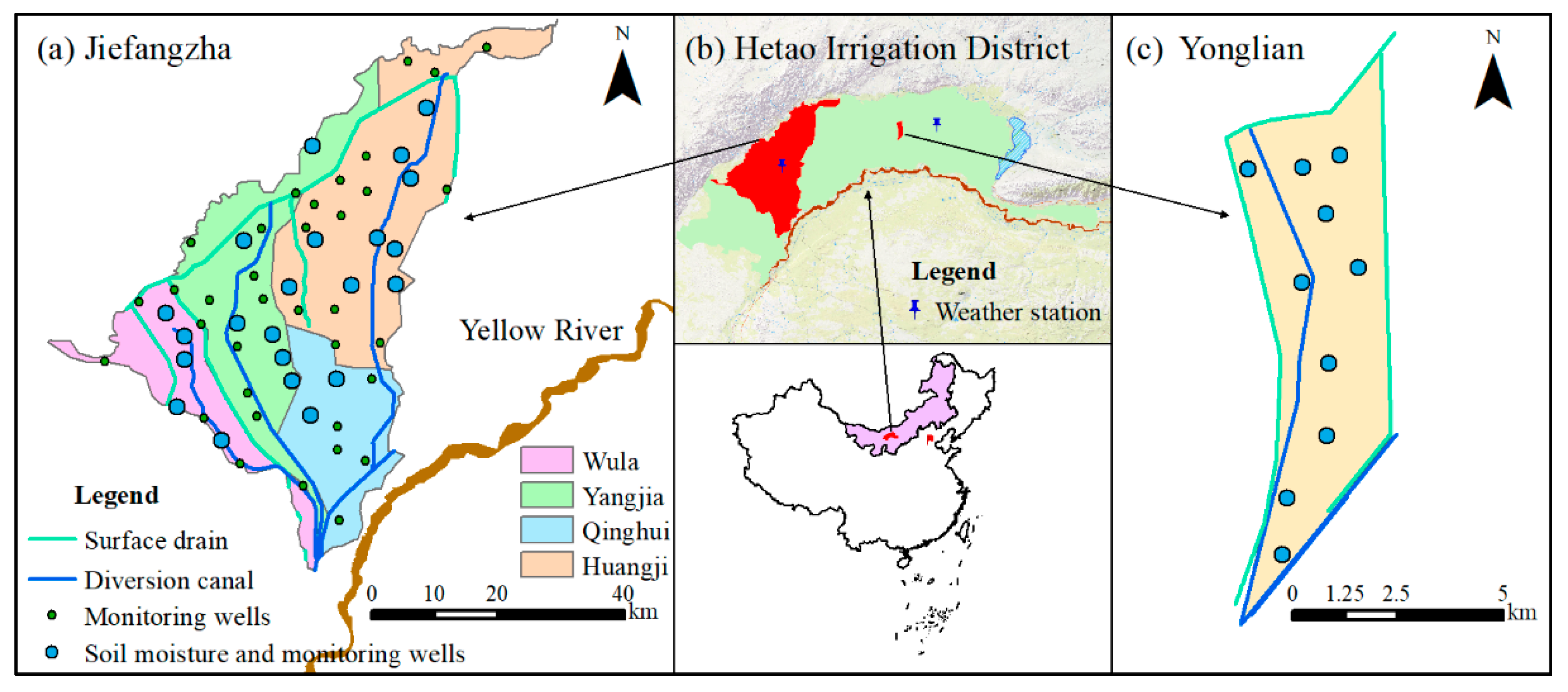
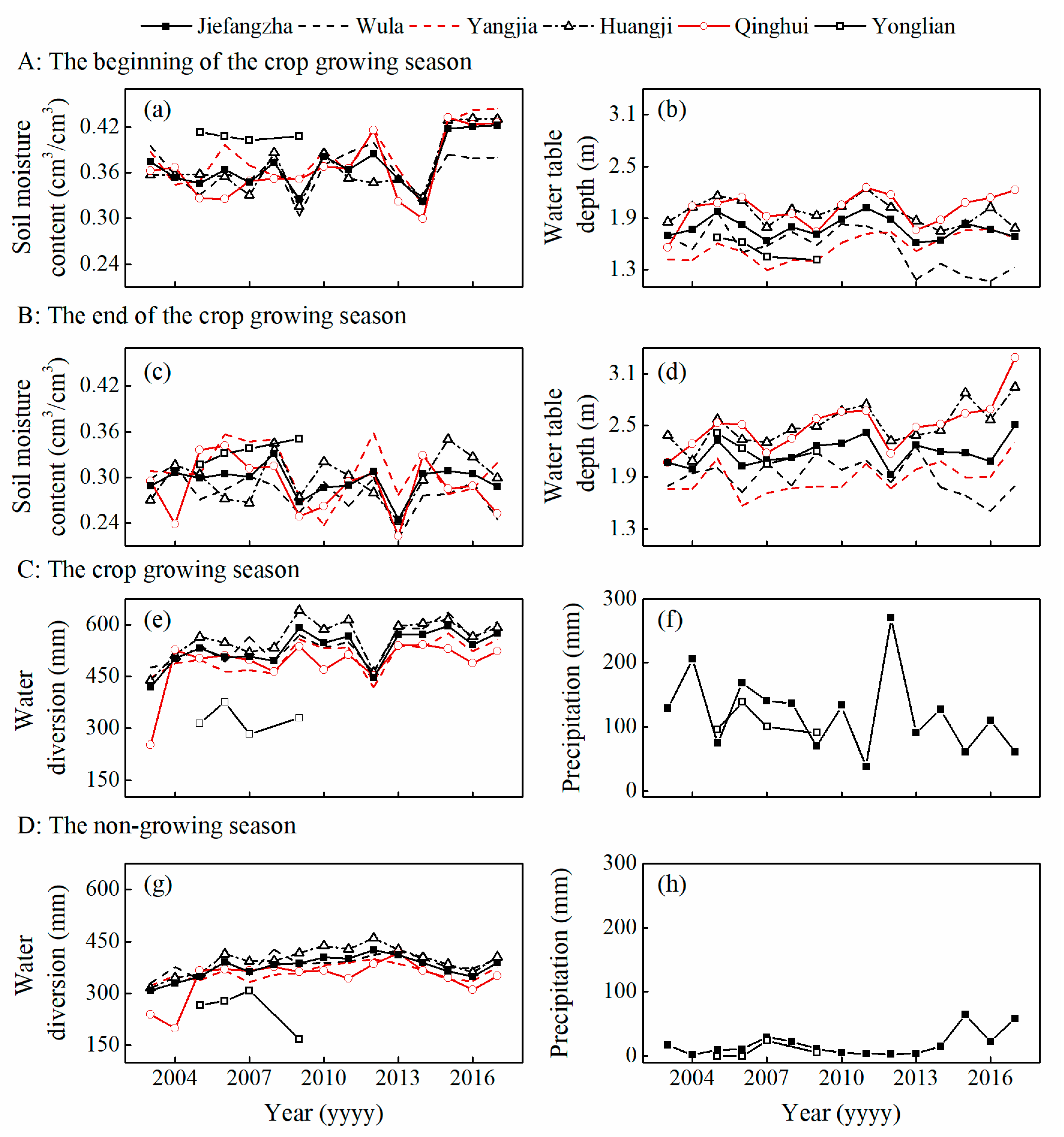
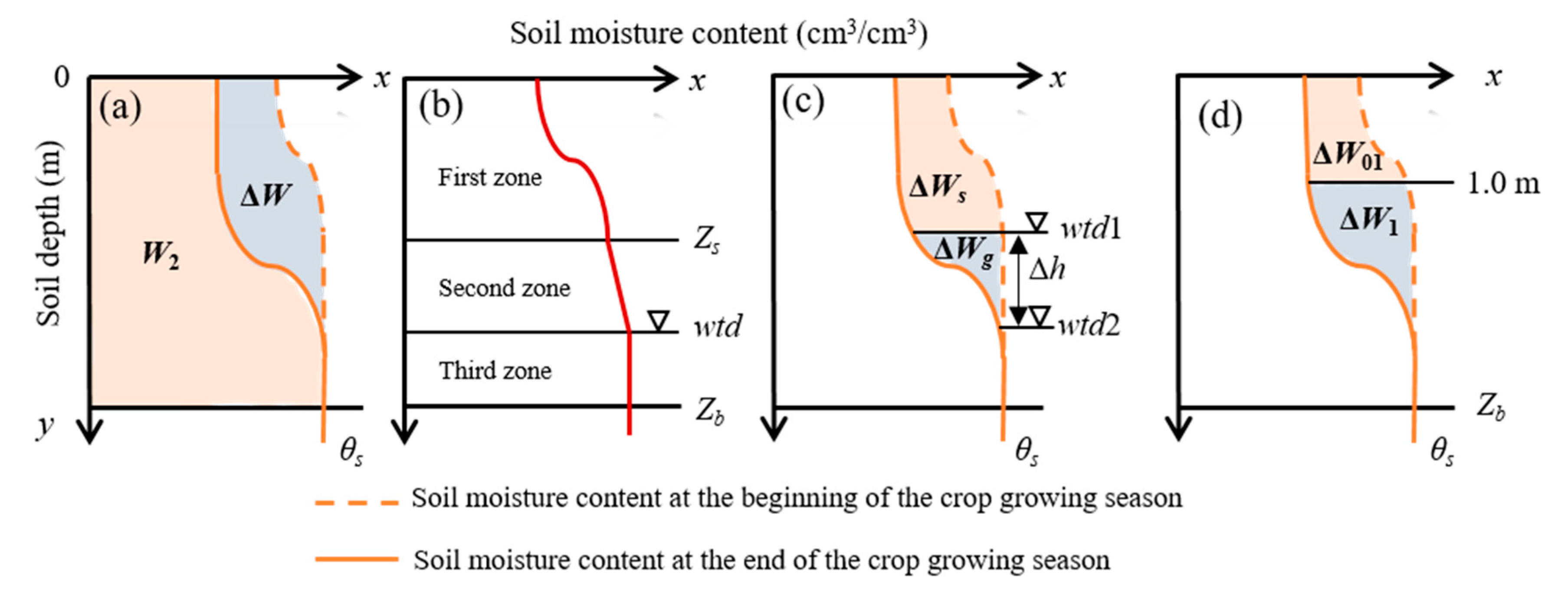
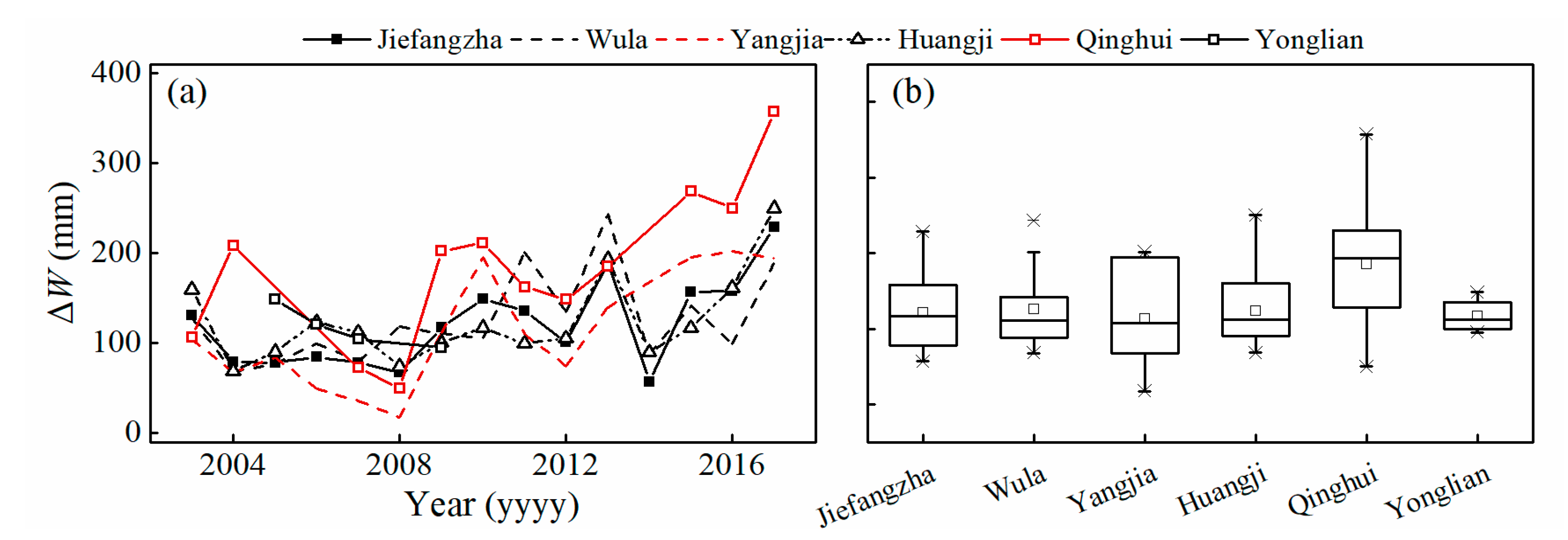

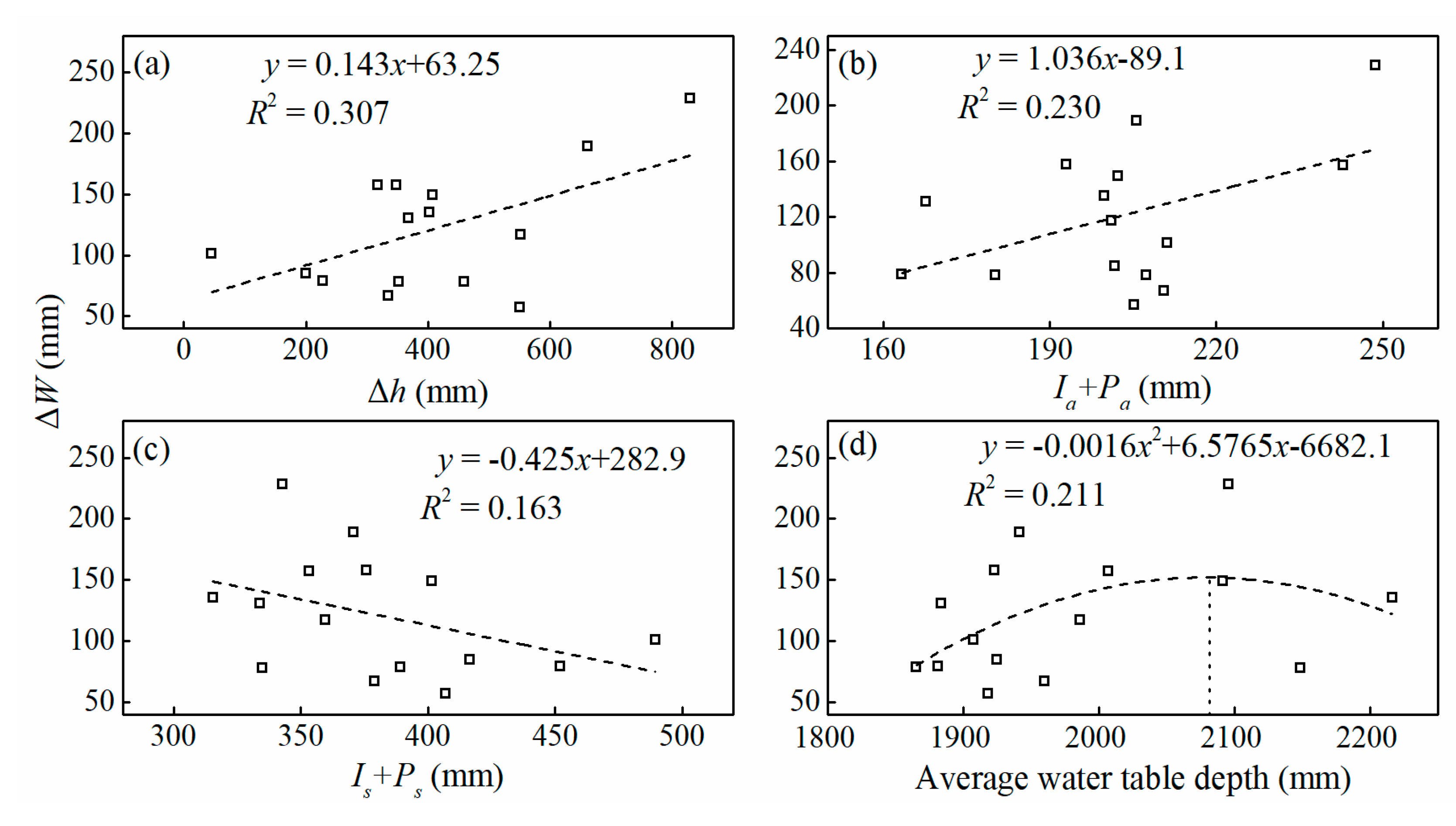
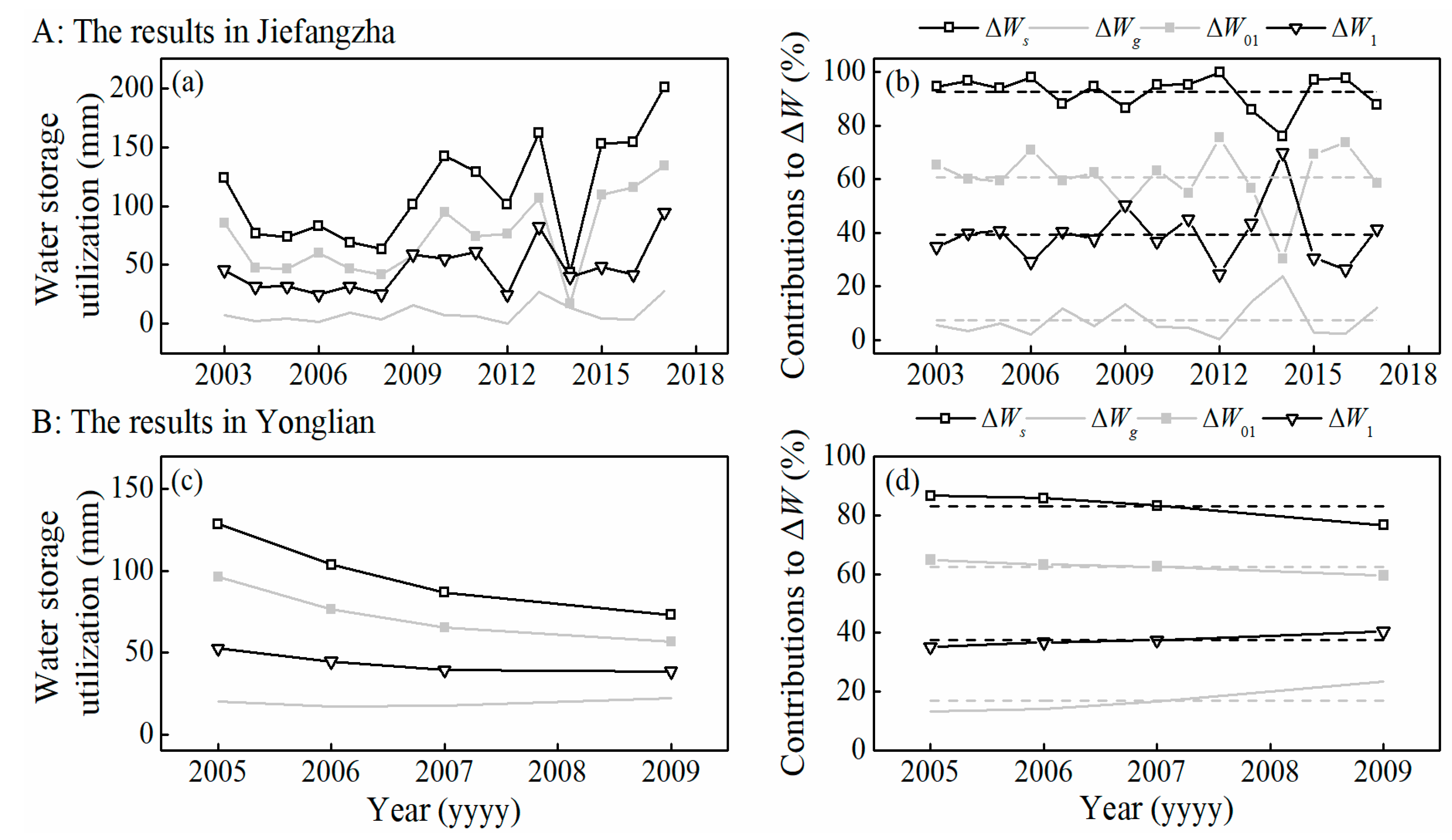



| Study Area | Irrigation Area (km2) | Annual Average Water Table Depth (m) | Number of Soil Moisture Content Monitoring Sites | Number of Water Table Depth Monitoring Wells |
|---|---|---|---|---|
| Jiefangzha | 1243 | 1.634 | 22 | 57 |
| Wula | 195 | 1.392 | 5 | 10 |
| Yangjia | 430 | 1.451 | 6 | 17 |
| Huangji | 497 | 1.787 | 9 | 23 |
| Qinghui | 121 | 2.042 | 2 | 7 |
| Yonglian | 20 | 1.461 | 10 | 10 |
| Study Area | Soil-Ground Water Storage Utilization (mm) | Average Utilization Efficiency of Autumn Irrigation (%) | |||
|---|---|---|---|---|---|
| Average | Maximum | Minimum | Standard Deviation | ||
| Jiefangzha | 121 | 229 | 57 | 49 | 32.2 |
| Wula | 126 | 243 | 68 | 50 | 32.5 |
| Yangjia | 113 | 202 | 18 | 64 | 31.5 |
| Huangji | 124 | 250 | 69 | 49 | 31.6 |
| Qinghui | 185 | 357 | 50 | 86 | 57.3 |
| Yonglian | 117 | 149 | 95 | 24 | 47.6 |
| Impact Factors | Tai | Si | Ss | Sa | Δh | Ia + Pa | Is + Ps | |
|---|---|---|---|---|---|---|---|---|
| Correlation coefficient (R) | 0.647 ** | 0.641 * | −0.572 * | 0.604 * | 0.554 * | 0.479 | −0.403 | 0.333 |
| Significance level (P) | 0.009 | 0.010 | 0.026 | 0.017 | 0.032 | 0.071 | 0.136 | 0.225 |
| Variables | Jiefangzha | Yonglian | ||||||||
|---|---|---|---|---|---|---|---|---|---|---|
| Average | Maximum | Minimum | Standard Deviation | Cv | Average | Maximum | Minimum | Standard Deviation | Cv | |
| ΔWs | 112 | 201 | 43 | 45 | 0.399 | 98 | 129 | 73 | 24 | 0.245 |
| ΔWg | 9 | 28 | 0 | 9 | 0.957 | 19 | 22 | 17 | 2 | 0.125 |
| ΔW01 | 74 | 134 | 17 | 33 | 0.442 | 74 | 96 | 57 | 17 | 0.233 |
| ΔW1 | 46 | 95 | 25 | 21 | 0.451 | 44 | 52 | 39 | 6 | 0.147 |
| ηg | 0.026 | 0.040 | 0.008 | 0.010 | 0.368 | 0.028 | 0.029 | 0.027 | 0.001 | 0.035 |
| η1 | 0.111 | 0.152 | 0.069 | 0.027 | 0.243 | 0.065 | 0.072 | 0.050 | 0.010 | 0.161 |
| η | 0.271 | 0.497 | 0.104 | 0.114 | 0.419 | 0.174 | 0.201 | 0.122 | 0.036 | 0.208 |
| Variables | Jiefangzha | Yonglian | ||||||
|---|---|---|---|---|---|---|---|---|
| Average | Maximum | Minimum | Standard Deviation | Average | Maximum | Minimum | Standard Deviation | |
| ET | 502 | 591 | 413 | 53 | 485 | 561 | 431 | 58 |
| RW | 23.75% | 40.00% | 12.31% | 8.31% | 24.21% | 29.93% | 21.15% | 4.04% |
| RW1 | 9.20% | 16.55% | 4.20% | 3.69% | 9.03% | 10.55% | 7.93% | 1.12% |
| RWg | 1.75% | 4.86% | 0.02% | 1.53% | 4.03% | 4.96% | 3.06% | 0.77% |
Publisher’s Note: MDPI stays neutral with regard to jurisdictional claims in published maps and institutional affiliations. |
© 2020 by the authors. Licensee MDPI, Basel, Switzerland. This article is an open access article distributed under the terms and conditions of the Creative Commons Attribution (CC BY) license (http://creativecommons.org/licenses/by/4.0/).
Share and Cite
Zhao, T.; Zhu, Y.; Wu, J.; Ye, M.; Mao, W.; Yang, J. Quantitative Estimation of Soil-Ground Water Storage Utilization during the Crop Growing Season in Arid Regions with Shallow Water Table Depth. Water 2020, 12, 3351. https://doi.org/10.3390/w12123351
Zhao T, Zhu Y, Wu J, Ye M, Mao W, Yang J. Quantitative Estimation of Soil-Ground Water Storage Utilization during the Crop Growing Season in Arid Regions with Shallow Water Table Depth. Water. 2020; 12(12):3351. https://doi.org/10.3390/w12123351
Chicago/Turabian StyleZhao, Tianxing, Yan Zhu, Jingwei Wu, Ming Ye, Wei Mao, and Jinzhong Yang. 2020. "Quantitative Estimation of Soil-Ground Water Storage Utilization during the Crop Growing Season in Arid Regions with Shallow Water Table Depth" Water 12, no. 12: 3351. https://doi.org/10.3390/w12123351
APA StyleZhao, T., Zhu, Y., Wu, J., Ye, M., Mao, W., & Yang, J. (2020). Quantitative Estimation of Soil-Ground Water Storage Utilization during the Crop Growing Season in Arid Regions with Shallow Water Table Depth. Water, 12(12), 3351. https://doi.org/10.3390/w12123351






